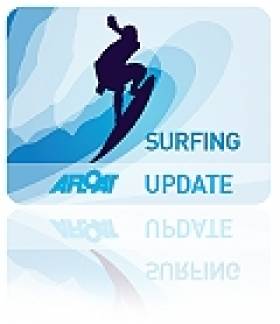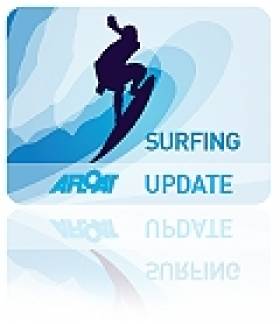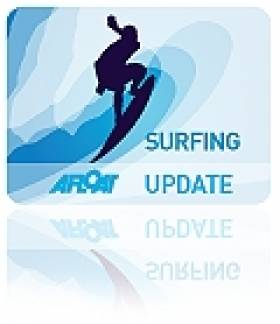Displaying items by tag: Shore Shots
Surfing In Ireland Is A Sure Shot For All Experience Levels
#Surfing - It’s no longer such a secret that Ireland has some of the most sought-after swells among the world’s top big wave surfing talent.
But beginners aren’t left out of Surfer Today’s list of '10 surf spots you must visit in Ireland', with Inchydoney in West Cork and Achill Island in Co Mayo noted for their scenery as much as their perfect starter waves.
Sligo features on the list with two wave hotspots, Enniscrone and Easkey — both just west of Sligo town, which again hosts the Shore Shots Irish Surf Festival on the weekend of 22-23 April.
The North West is also the ancestral home of Irish-Australian surf pro Mick Fanning — famous for his close call with a shark off South Africa in 2015 — who recently paid a visit to sample the surf for himself, as documented in this new Rip Curl video:
Upcoming Festivals Show What's Up With Irish Surfing
#Surfing - The biggest cash prize in Irish surfing will be up for grabs again this summer at the Sea Sessions Surf and Music Festival.
As JOE.ie reports, the Expressions Session is set to attract the biggest surfing names in Europe and beyond to Bundoran from 19-21 June for the €3,500 purse claimed last year by 17-year-old GearOid McDaid.
But you won't have to wait that long for the next surfing celebration in Ireland, as the popular Shore Shots film festival returns to the Light House Cinema in Smithfield on 11-12 April.
This year's events includes a live talk hosted by Banter that aims to ask the question: 'What's the story with Irish surfing?'
Big wave luminaries such as Peter Conroy of the Irish Tow Surf Rescue Club, MagicSeaweed editor Ed Temperley and Brian Britton of the legendary Donegal surfing clan will be on hand to discuss what makes Ireland such a strong destination for surfing.
Jim Carroll's On The Record blog has more on the story HERE.
Shore Shots Surf Film Fest Returns Next Month
#Surfing - Following last year's successful inaugural event, the Shore Shots Irish Surf Film Festival is returning in 2014 to the appropriately named Light House Cinema in Dublin's Smithfield on 5-6 April.
After one of the best winters on record for Irish surfing, surfers from across the island will be gathering for two days in the capital to check out the latest waveriding adventures as seen through the lens of filmmakers and photographers.
Among the line-up of hotly anticipated surf edits from the country’s best surfers and film-makers, photography and video from around the globe will be screenings of Uncharted Waters, a profile of 1960s Aussie surfing legend Wayne Lynch, and The Old, The Young and The Sea, a road movie following Europe's premier surfing route from France to Portugal.
And a weekend celebrating Ireland's second ever surfing themed film festival wouldn't be complete without the now infamous Shore Shots Afterparty, hosted across Smithfield Square at the Generator Hostel.
For more on the festival and how to book tickets for screenings and the afterparty, visit the Shore Shots website HERE.
Shore Shots Film Fest Is 'Roaring Success'
#Surfing - Ireland's first ever surfing themed film festival has been hailed as a "roaring success" all round, according to surf website Magicseaweed.
The Shore Shots Irish Surf Film Festival - which took over the Light House Cinema and the Generator Hostel in Dublin's Smithfield last weekend, as previously reported on Afloat.ie - featured the Irish premieres of five new big-screen surfing films, including the 3D epic Storm Chasers.
But it was the Short Film section attracted the most excitement and plaudits over the two days, with an edit of Fergal 'Ferg' Smith - tackling the biggest and best waves Ireland has to offer over two years - claiming top prize in the category.
Others of note in the shortlist include bodyboarder Peter Clyne and some truly exciting POV footage from Dylan Scott - shot with a single GoPro and put together on the smallest of budgets.
North Of Nowhere from Peter Clyne - Outer Cells on Vimeo.
trendynewatrocity2 - By Dylan Stott from MSW on Vimeo.
Magicseaweed has much more on happenings from the festival HERE.
Ireland's First Surf Film Festival Comes To Smithfield
#Surfing - Ireland's first ever surfing themed film festival is set to take place in Dublin later this month.
The Shore Shots Irish Surf Film Festival 2013 will take over the Light House Cinema and Generator Hostel in Smithfield on the weekend of 23-24 March with the Irish premieres of five new big-screen surfing titles.
"We’ve got all the latest footage from the global surf scene, award-winning movies and tales of travel and adventure from men and women who have devoted their lives to exploring and sharing the water around us," say the organisers.
The festival kicks off with the premiere of Here & Now, the work of more than 25 filmmakers and surfers who worked together to document the world of surfing in a single 24-hour period.
It's followed the the first Irish showing of the epic 3D adventure Storm Surfers, a documentary following two best friends on their quest to hunt down and ride the biggest and most dangerous waves in Australia.
The second day will see showings of 180 South, which retraces the epic 1968 journey of Yvon Chouinard and Doug Tompkins to Patagonia; North of the Sun, documenting two surfers extreme experience throughout nine months of winter in a remote part of Norway; and Come Hell or High Water, which tells the remarkable history of bodysurfing.
Both days will also feature an exhibition of stunning surf photography captured by some of the best in the business, a short film competition - and a proper party atmosphere!
Find out more at the official festival website or the Shore Shots Facebook page.




























































